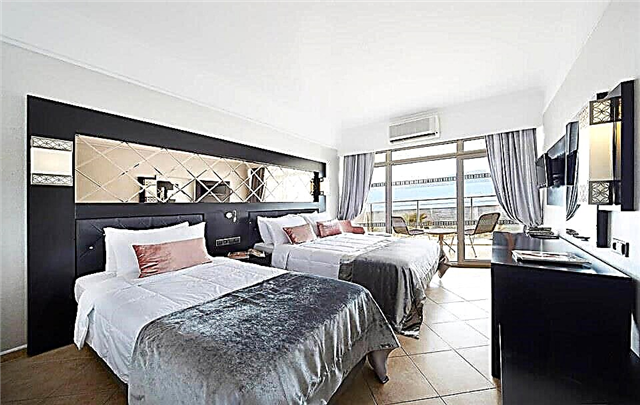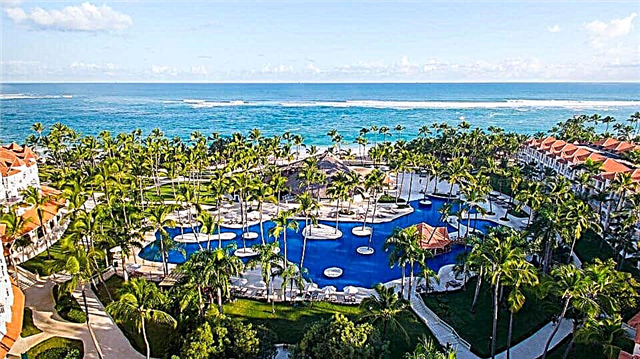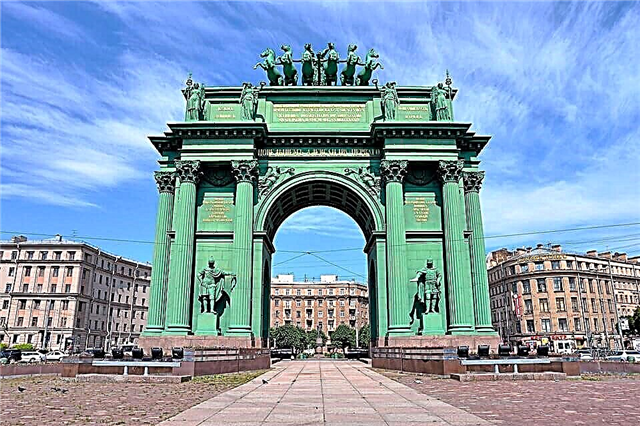One of the grandiose architectural monuments of the Russian Federation is the Narva Triumphal Gate in St. Petersburg. The monument, erected in honor of the great victory of the Russian army over the Napoleonic troops, amazes with its grandeur and simplicity, beauty and nobility.
Construction history

In the spring of 1814, it became known about the victorious return of Russian hero-soldiers from a foreign campaign. All residents with enthusiasm began to prepare for their solemn meeting. At an emergency meeting of the Senate, convened on the initiative of General Vyazmitinov, it was decided to erect the Arc de Triomphe on the route of the guards regiments.
Wooden Triumphal Gates
Since there was very little time left to create a monumental structure of stone or other durable material, a temporary one was built from alabaster and wood. The author of the project was the architect Quarenghi. An arch for the solemn passage of troops was erected at the Narva outpost, located on the very outskirts of the city (hence the name of the monument), not far from the Obvodny Canal. The construction took a little over 30 days.
The building was crowned with a sculptural ensemble - the figure of the ancient Greek goddess of Glory on a chariot drawn by six horses. The composition was made according to the project of the sculptor I. Terebenev. On the walls there are inscriptions in golden paint, where the names of the regiments participating in the battles are indicated, and the words of thanks from the Russian people. At the bottom of the building are statues of Roman legionnaires.
On both sides of the colonnade, the builders erected stands for greeters and an amphitheater for a military orchestra. Alexander I, his family and influential guests were to settle in specially built covered galleries. All residents, both ordinary people and high-ranking ones, greeted the victorious regiments with glee, including Semenovsky, Preobrazhensky, Yegersky and others. This year, Russian troops four more times, from July to October, marched through them into the city in triumph.
After the celebrations, the area around the monument became a popular place, a local attraction - the townspeople met here on holidays and weekends. But the material from which the arch was erected was short-lived (wood and alabaster), and after 10 years the building began to gradually collapse. The authorities of St. Petersburg raised the issue of dismantling the structure, but most of the residents, among whom were participants in the hostilities of 1812, were in favor of its reconstruction. Emperor Nicholas I was on the throne at that time, he ordered the construction of a new, stone structure.
Construction of stone gates and cladding with copper sheets

For the second time, the arch was erected in memory of the participants in the Patriotic War in 1827-1834 according to the project of V.P. Stasov. The authors are sculptor S.S. Pimenov P.K., Klodt, V.I.Demut-Malinovsky. Unlike the first building made of wood, solid bricks were used for the construction of the new one, while the architecture of the structure remained largely unchanged. Copper sheets were used to create details to decorate the façade. In addition, figures of ancient Russian knights were installed here. The structure has many differences from the objects that were being built at that time - this is the absence of numerous details, the severity of the design.
Stages of restoration
Copper sheets, which were used in construction, began to corrode after a few years, in which the humid climate of the Northern capital played an important role. At the end of the 70s, the first restoration began under the direction of the architect M. Ryllo. After the completion of the work, the archive of the City Duma was placed in the building, but it burned down during the February Revolution - the striking soldiers and workers set fire to the monument. In addition, bronze decorations were damaged.
In 1925, another long-drawn-out repair of the arch began; the outbreak of the Second World War prevented the completion of the restoration work. During the hostilities, the building suffered significant damage during air raids, since the front line was not far from it. Once again, Soviet soldiers who won a bloody war passed through it with triumph. The post-war restoration was continued in 1949 according to the project of I. Benois. The work went on for almost three years, as a result of which the roof, spiral staircases and floor covering were replaced. Decor elements and damaged parts of the monument have been restored.
During the renovation in 1978-1980, a site was equipped around the monument, obsolete engineering communications were replaced. We have equipped an underground passage - now you can get to the arch conveniently and safely. The roof was repaired and the copper sheets were cleaned, some of them, like the details of the ornament, were replaced with new ones. The lower part of the columns, internal spiral staircases were restored, and the original color was restored. It was not possible only to put in order the face of the Goddess of Glory, which, presumably, suffered from the vibration of city transport.
Sculptural compositions

The arch is crowned with a sculptural composition - six horses (sculptor P. Klodt), which are ruled by the ancient Greek goddess Nike. She holds in her hands the symbols of glory and peace - a palm branch and a laurel wreath (sculptor S. Pimenov). In the niches of the pylons there are figures of ancient Russian warriors made according to drawings by Pimenov and Demut-Malinovsky. Sketches of clothes, weapons and armor of the heroes were made by sculptors from original samples stored in the Kremlin Armory.
Tokarev and Krylov performed the figures of geniuses over the columns. The sculptor Leppe created bas-reliefs of flying glories on the sides of the arch. On the columns you can see the inscriptions made in gold, dedicated to the Russian guards. Since the copper plates quickly corroded, they were subsequently made iron, but this material also quickly corroded.
Appearance

The Triumphal Gates are designed in a simple and austere style, following the pattern of ancient Roman palaces. They are a grandiose structure with a height of more than 30 m, a width of 28 m, the size of the arch from the inside is 8 mx15 m.On all sides, the building is surrounded by twelve columns decorated with Corinthian capitals (the capital is the crowning part of the column) with a diameter of 1 m. the samples are made in the form of flutes (vertical column groove).
On the walls, the creators placed an inscription of gratitude from all the people of Russia, the text on the attic reads: "The victorious Russian Imperial Guard Appreciated Fatherland." Also, the names of the guards regiments participating in the hostilities of 1812, including Ulansky, Cossack, Gusarsky, Dragunsky, were immortalized. On the west side, the names of the cavalry formations are written in gold letters, on the east - the infantry units are listed. Another inscription reminds of the battles in which our troops took part, including in the settlements: Borodino, Leipzig, Paris and others.
Area

The architect Stasov also designed the square on which the monument to the heroes is located. The author insisted on a large open space, since the structure is much better visible from a considerable distance. In addition, to emphasize the dominant position of the Narva Gate, they were installed on a small hill. This is exactly the effect the creators of the layout sought, they succeeded in full. In 1834, soldiers of the guard service were housed in the building.
Country houses, which were located in large numbers in this place, were eventually demolished, apartment buildings and factories began to be built. At the end of the 19th century, there was a work outpost here."Stachek Square" - this name was received after the October Revolution, as workers strikes often took place here. In 1924 it was decided to re-plan the square, the author of the project was the architect L. Ilyin. The Tarakanovka River, which runs through the square, and the old buildings were removed. Instead, they built a spacious, beautiful square that still exists in our time.
In 1927, the Moscow-Narva Palace of Culture was opened here, later named after the Soviet writer M. Gorky. In 1928-1931, a kitchen factory began to work and the Kirovsky department store, impressive for that time, was opened. In the 1930s, a complex of residential buildings was created. In 1955, the Narvskaya metro station was built in the style of “Stalinist classicism”. In 1956, the construction of the hostel of the Leningrad Institute of Water Transport was completed. In 1979-1980, an underground passage was erected under the building. In 1999, a monument to the Great Patriotic War Marshal L.A. Govorov was erected on the square.
The shopping center "Gallery 1814" received its first buyers in the spring of 2005. The building is equipped with an automatic modern control system that combines lighting, heating, fire alarm, ventilation, water supply and others.
Museum

In 1987, a museum was opened inside the Arc de Triomphe. It is located on the top floor of the building, which can be accessed via two narrow spiral staircases. The exposition presents photographs from different years, including those telling about the tragic events of the Second World War, attributes of the liberation campaigns of 1812-1814. Thematic exhibitions are regularly held here, united by a single theme - Petersburg in the war years. Also on display are sculptures, objects of applied and fine arts.
The museum has a permanent exhibition of the artist Andrei Romasyukov "Dust of Time". The author devoted his works to various events that took place in the first quarter of the 20th century, mainly during the First World War. In total, the exhibition features about 15 paintings. Here, visitors are offered to buy brochures about the history of the construction of the facility, as well as about the heroic deeds of Russian soldiers. The ticket office for the museum is located at the bottom at the entrance.
- The ticket price is 100 rubles, for the privileged category - 60 rubles.
- Open from 11:00 to 17:00.
- Non-working days: Monday, Tuesday and last Friday of the month
Where are they and how to get there
The monument is located in St. Petersburg at the intersection of Stachek Avenue, Staro-Peterhofsky Avenue, Narvsky Avenue and Perekopskaya Street. It is more convenient to get to the metro station "Narvskaya".
Ground transportation:
- Tram number 16
- Trolleybus No 20
- Buses: routes 1M, 2, 6,35, 66, 73
- Route taxi: K1, K2, K6k, 47, K177, K195, K306
The monumental majestic building dedicated to the feats of arms of Russian soldiers is not as famous and visited as other sights of St. Petersburg. But it is interesting and unique from the point of view of history and culture, not only of the city, but of the entire vast country, so you should definitely visit this landmark place for all Russians.











